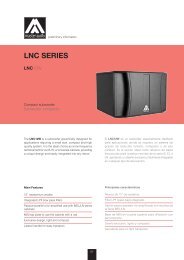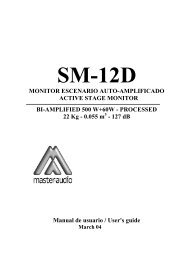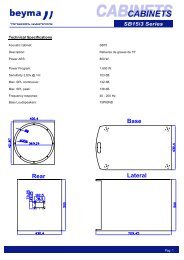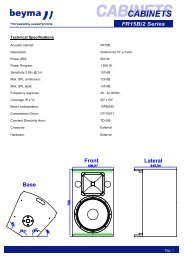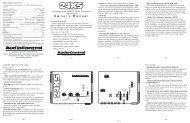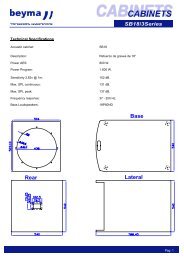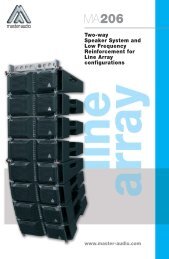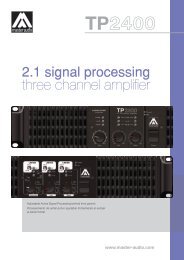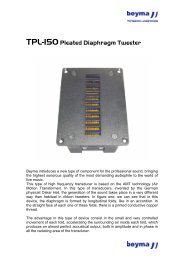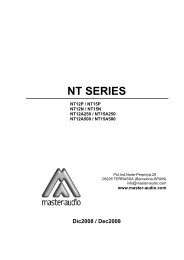PRO SERIES
PRO SERIES
PRO SERIES
You also want an ePaper? Increase the reach of your titles
YUMPU automatically turns print PDFs into web optimized ePapers that Google loves.
Amate Electroacústica,s.l.<br />
3.4.Difusores asimétricos y giratorios<br />
Los modelos P-10A / P-12A / P-15A / P-212 /<br />
P-12SMA / P-15SMA incorporan difusor de<br />
dispersión asimétrica que permite optimizar la<br />
cobertura tanto en posición horizontal como en<br />
vertical.<br />
Para girar el difusor se debe desmontar primero<br />
la reja frontal, destornillar el difusor por sus<br />
cuatro puntos de fijación y girarlo 90 grados<br />
teniendo cuidado de no desconectar los cables.<br />
Volver a atornillarlo y colocar de nuevo la reja.<br />
En una sonorización normalmente se intentará<br />
establecer un compromiso entre las zonas a<br />
cubrir. Interesará:<br />
*cobertura amplia para los oyentes más<br />
cercanos (short throw)<br />
*cobertura más estrecha para los oyentes más<br />
alejados (long throw)<br />
Los difusores con dispersión asimétrica varían<br />
su cobertura horizontal, "simulando" un<br />
barrido desde el "short throw" al "long throw"<br />
a lo largo del eje vertical (que mantiene la<br />
directividad constante). En resumen, las<br />
características de directividad de nuestros<br />
difusores (50º a 100º(H), 55º(V)), pueden<br />
interpretarse de la siguiente manera: existen<br />
dos directividades en el plano horizontal<br />
(cobertura de la audiencia) que varían en<br />
función de la distancia. Normalmente, a menor<br />
distancia consideraremos como óptimo el<br />
ángulo más abierto (100º) mientras que para<br />
distancias grandes, el ángulo apropiado será el<br />
de 50º.<br />
Entenderemos mejor la teoría con unos<br />
ejemplos prácticos.<br />
3.4.Asymetrical and rotatable horns<br />
The P-10A / P-12A / P-15A / P-212A / P-<br />
12SMA / P-15SMA models incorporate an<br />
asymmetrical dispersion horn which will<br />
optimise coverage either in horizontal or<br />
vertical position.<br />
To rotate the horn, unscrewed the frontal grille,<br />
and then, unscrewed the four fixing screws of<br />
the horn. Rotate it 90 degrees taking care of the<br />
wires. Screw the horn again and finally place<br />
the frontal grille in its right position.<br />
Good coverage of audiences often is a<br />
conflicting combination of:<br />
* wide coverage for the closest audience (short<br />
throw)<br />
* narrow coverage for distant areas ( long<br />
throw )<br />
The asymmetrical dispersion horn coverage<br />
varies from "short throw" to "long throw"<br />
along the vertical axis (keeping a constant<br />
vertical directivity). In conclusion, directivity<br />
feature of (50º to 100º(H), 55º(V)) can be seen<br />
as if the horn itself had "two" horizontal<br />
directivities (audience coverage), which<br />
depend on the distance. For short distances the<br />
horn should be used with its "wide" dispersion<br />
(100º). For long distances the horn should be<br />
used with its "narrow" dispersion (50º).<br />
We suggest to pay attention to the following<br />
examples.<br />
<strong>PRO</strong> Series.Version 1.1 Sep 07 18



